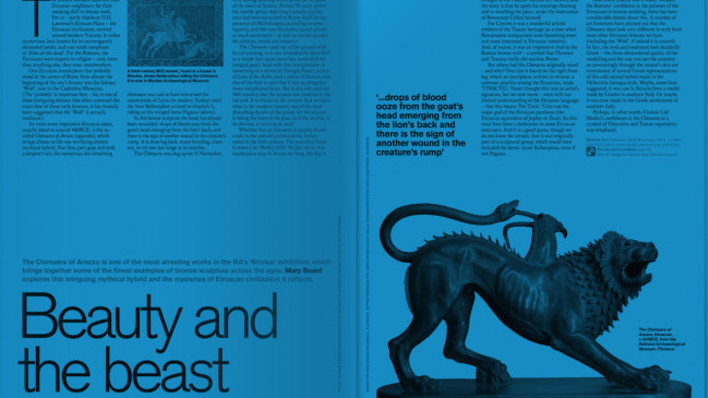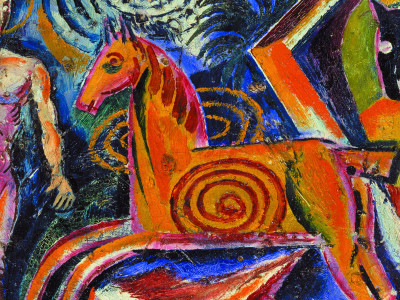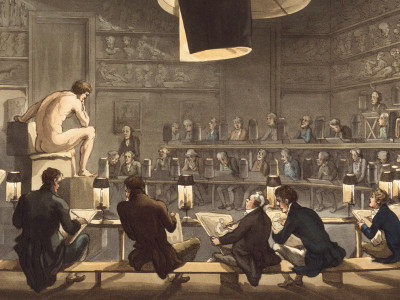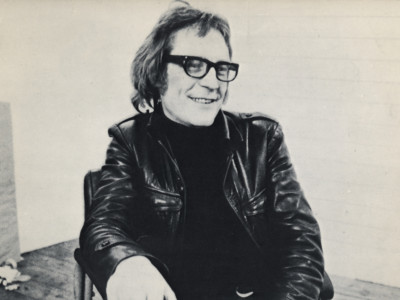
Meet three artists in the RA Schools Show 2021
By Charlotte Jansen
Published on 13 June 2021
From PVC-clad performance art to site-specific sculptural interventions, the work of RA Schools students has thrived despite the pandemic. Charlotte Jansen meets three of the artists as they prepare their long-planned final-year show.
Charlotte Jansen is a contemporary art journalist and commissioning editor at Elephant.
Last March, just a few days before the first lockdown, I arrived at the RA to meet some of the third-year students in their studios at the RA Schools. I was there to interview them ahead of their final-year show, for an article to be published in the Summer 2020 issue of RA Magazine.
At that stage, no-one could have predicted the scale of what was about to happen, but even so, the corridors were humming with the anticipation of the unknown; only at an art school could a looming cataclysm cause as much excitement as anxiety.
The main preoccupation of the students at that point was their exhibition – the physical apotheosis of three years of study; around me, floorboards were being excavated, electronic devices rewired, and charcoal spilled. Casting furtive glimpses into studios as I passed revealed the chaos and stress of work in progress.
Olu Ogunnaike
"There was this crescendo then an explosion, and then it all came crashing down – the shutters were literally pulled down," student Olu Ogunnaike recalls, as he reflects on the closure that soon followed our interview. This time we are speaking over the phone, though Ogunnaike has been able to return to his studio at the Schools, after long stints working elsewhere, and nowhere.
He is one of the 16 students who make up the ‘Class of 2020’ (the group has proudly kept their allegiance to their planned year of graduation), all but one of whom opted for the ‘catch-up year’ offered by the Schools to its students, to make up for time lost during the closure. This offer was only possible because the RA Schools is independent of public funding; tuition is free to all students, thanks to the income from Friends memberships, other donations and Summer Exhibition sales.

"I’ve kept this material kind of private, I don’t know why. It used to be a kind of trademark in my work, before I came to the Schools, but then I started screenprinting and sort of left it to one side. But it has re-emerged at the forefront of my practice."
The architectural interventions are "about my warmth for the place, as well as my former unease," he says. "OSB is a building material often used to keep people out of spaces, but here it becomes an invitation to enter." In a separate space, he will show his charcoal works. "That’s where I want to get more personal – to capture the tears and smiles I share with my family."
Like many artists working over the past year, Ogunnaike has been reflecting hard on the wider meaning of making art, its place and purpose in the world. Art and culture has been classified as ‘non-essential’ by the Government, yet creativity in general has become a vital survival strategy for many, and has played a far more important role in many people’s day-to-day lives than previously.
"I think for the whole year, the students have been thinking a lot about art – how it’s received, what it could be and do – in radically different ways," observes senior lecturer Brian Griffiths, the head tutor of the course’s third year. "What’s the meaning of art in this new perspective?" Griffiths’ own perspective as an artist has been challenged by the pandemic and has given him greater conviction in the belief that art is a way of navigating the world.
Personally, I don’t care what students come out making: it’s about what you value, the way of working, the way of being in the world, what sustains you – that’s what matters.
Brian Griffiths, RA Schools Senior Lecturer
Finding solace in friends and family over the past year, Ogunnaike has emerged more poised in his practice. Gone are the plumes of charcoal dust – the mythological mess Ogunnaike used to leave in his wake that I heard so much about last year. Though charcoal remains one of the "bullet points" of his practice, he is more "surgical with it now", he says.
His final presentation will include the large-scale charcoal screenprints he has been mastering, as well as architectural interventions within the communal spaces of the art school, including remaking the doors joining the Royal Academy and the Schools.
These sculptural additions to the fabric of the building will be made from oriented strand-board or ‘OSB’, typically an industrial engineered wood product, which Ogunnaike has been making by hand for a decade (a ‘pastiche’, in his words). "It’s a rarefied version of what’s usually a throwaway building material," he says. It reveals a side of his practice that he has kept to himself up until now.
Ayo Akingbade
Artist and filmmaker Ayo Akingbade is one of a handful of students who didn’t opt for the catch-up year, which means she is graduating a year in advance of her original second-year peer group. But, she says, this is in part down to the fact her experience over the past three years at the Schools has been such a positive one. "I really enjoy studying here, the resources – anything is possible. And I’ve slowly matured, in the sense of knowing what I want to do with materials and my studio practice," she says via Zoom.
Akingbade trained in film at the London College of Communication before applying to the RA Schools. It is at the RA that she has found a strong stance in her filmmaking and has established a studio practice – having once felt the term ‘artist’ was too elitist to belong to her, she is more accustomed to it now.

In her film works, she often returns to the question of the place and purpose of the artist. Her studio, she tells me, is a surprising cabinet of her own curiosities, the people and objects that inspire and inform her art – a cardboard cut-out of Naomi Campbell, pictures of Tina Turner, images of paintings by Gerhard Richter, a photograph of the choreographer Okwui Okpokwasili, a poster of the reggae band Black Uhuru, watermelon casts she made in her first year, moulds of her hands.
Her influences range from the work of contemporary artist Anthea Hamilton to a love of 80s fashion, Sade’s music, Jane Birkin’s jeans and French New Wave films. "I’m always inquisitive about things," she says. Her own films have something of French New Wave energy about them – the roaming camera, the improvisational quality, and the quiet confidence and natural rhythm. But the scenery and perspective is distinctly Akingbade’s own.
This summer, Akingbade is showing two films at the Whitechapel Gallery, drawn from her No News Today trilogy about social housing in London; she’s also included in a prestigious group show at the Lisson Gallery. For her RA show, she is working on a six-minute film, Red Soleil (2021), an ode to the French director Eric Rohmer. Shot off the coast of Brighton, it features "a young lady, played by myself – maybe it is me – trying to chase the sunset."
She’s also working on monoprints on aluminium and photographs of earrings, and another film of a spinning colour wheel, an attempt to catch the shape and movement as it turns white. These, she adds, "are not meant to be masterpieces… They’re just experiments." Given the events of the past year, this modest statement of intent might be what makes most sense now.

Jenkin van Zyl
Jenkin van Zyl’s practice also centres around filmmaking, often incorporating elaborate costume and set design inspired by old fantasy and horror movies. A member of the ‘Class of 2020’ like Ogunnaike, Van Zyl had been shooting on a remote abandoned Hollywood filmset in Iceland in -20C conditions just as the pandemic hit. "We were just in Playboy bikinis and silicon tits – we got hypothermia filming," he recalls, when we speak over Zoom.
"The film was about the permeability of the body, isolation and crisis – and suddenly that was being considered in real time on a daily basis, and it felt really hard to finish the work – it was too conclusive, too glib. So I shelved it for a long time." Van Zyl was able to do this thanks to the catch-up year, which was "pretty much the most thoughtful, generous thing" the Schools could have offered its students.
So much art has the liberal imperative to state your identity and nothing more; I find that limiting and boring, and not a good way to make queer art.
Jenkin Van Zyl
The film, Machines of Love, on which he is working for his final show, follows a group of characters who arrive in a bunker city. Among the events that follow, they begin to breed cakes that become replicas of their own faces. To mirror the atmosphere of the set, Van Zyl will present the film at the Academy inside an environment that reflects the work. (It will also be shown at Tramway in Glasgow, as part of Glasgow International, but with a different sculptural setting.)
A perfectionist’s eye for detail is typical of Van Zyl, who is also celebrated for his visionary costumes – think child of Boy George and Leigh Bowery, with added latex. Van Zyl not only wears these ornate costumes on set, but to go the corner shop or out for a walk. "The work I make is embedded in subcultural ideas of fantasy and their politics. The way I live and present my identity is linked to that, but that presentation can rapidly become a type of PR, and my artworks are a refuge from that."

While art values originality more than most social media platforms do, it too can breed reductive categories, in Van Zyl’s view. "So much art has the liberal imperative to state your identity and nothing more; I find that limiting and boring, and not a good way to make queer art," he says.
"Identity in my films is a lot more unstable – it’s serious and joyful, slippery and collapsed. The works are multiple and collaborative, and I tend to use these silicone prosthetic masks that render all the characters into these nearly-monstrous, almost-human interchangeable avatars."
Van Zyl’s ambition, he says, is for his work to "create pockets of progress and imagination within a larger political landscape of deadlock and a sense of long emergency." It provides a place for thinking about what comes next, something many of us haven’t allowed ourselves to do for some time. It might not be up to artists to provide hope but, as Van Zyl puts it, they open up possibilities and potential, and offer the best attempt, "to imagine, if not a better, then a different future."

Visit the RA Schools Show 2021
Following a year-long pause due to Covid-19, the RA Schools Show returns.
16 artists – having just completed their postgraduate study at the RA Schools – transform their studio spaces to show new work.

Enjoyed this article?
As well as free entry to all of our exhibitions, Friends of the RA enjoy one of Britain’s most respected art magazines, delivered directly to your door. Why not join the club?
Related articles

Visions from Ukraine
19 June 2024

10 RA Schools stories through the centuries
16 May 2024

In memoriam: Mick Moon RA
1 May 2024